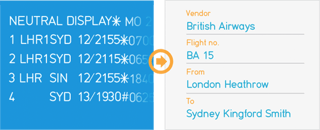
In previous blogs, we’ve covered the importance of the GDS to the travel industry and there can be no doubt it’s a vital spoke in the industry’s wheel. However, simply using a GDS is not the same as harnessing its full potential for your TMC. Here, we look at a few options for wringing the most out of your GDS and providing your travellers with the best possible experience.
Make Life Easier for Your Travellers
A simple one to kick things off. While the GDS has always been great at consolidating data, there’s often been a disconnect between its software developers and the traveller at the end of the process—after all, GDS developers work with the TMC in mind rather than the traveller.
What this often means is that the delivery of customer documents such as travel itineraries can lack consideration for user experience. No business traveller wants multiple itinerary emails, delivered from disparate sources, in a hard-to-read format and littered with irrelevant third-party advertising—yet this is often what they get.
It’s no use providing your travellers with all the information they need for a smooth trip if that data is presented confusingly. So, what can you do?
Keep it simple by using a travel itinerary template plug-in for your GDS. These consolidation tools take GDS data and deliver it to your travellers in a single, easy-to-read document. It’s a simple solution, but one that can work wonders for your traveller satisfaction and ensure that the rich seam of data being provided by your GDS actually benefits the end-user.
And for Your Staff
If things can get confusing for the traveller, spare a thought for travel managers. In no particular order, travel managers are tasked with juggling: visa checking, scouting out the best deals, sourcing hotels and ground travel, finding the right seats for the traveller, and checking (and double checking) whether everything has been ticketed correctly.
On top of this, the data provided by the GDS is often delivered in a near impenetrable alphabet soup of acronyms, symbols, and numbers.

Above: What GDS data looks like when it comes through vs plain English.
Hardly the best foundation for working efficiently or at the top of your game. So, there’s a lot to be said for trying to simplify processess as far as possible for your travel managers and allowing them to get on with the most important part of their job: looking after the traveller.
Fortunately, there are a wealth of additional plug-ins and tools on the market to help you do just that.
First up, decoders for GDS data. These capture information from an active window in the GDS, decode the text and deliver an accurate, user-friendly document, and all in the Queen’s English (or American for our cousins across the pond). This can save travel managers vital time they would have spent decoding the data manually, instead allowing them to access and make use of the data instantly.
Likewise, automatic visa checking and automated ticket inspectors can help you cut out long hours spent researching visa requirements or triple checking each traveller's ticketing details. Both come with the added advantage of being less likely to miss something than a weary travel manager at the end of a long day at the office.
Finally, PNR management tools are a great way to get a handle on the onerous task of cross-checking policies, requirements, and the latest offers for each individual traveller’s booking. These add-ons allow travel managers to program a set of rules for each client to track individual needs, the latest route deals and changes to company policy.
It’s all about making the GDS work better for your staff. Your GDS provides all the raw data needed to deliver a first-rate service to travellers, but you'll sometimes need to perform a little tweaking to use it in the smartest possible way—which is the way that limits the time your travel managers spend on onerous tasks with a high margin for error.
Augment it with a 3rd-Party Integration
We live in a world defined by choice, and while the GDS offers plenty, there's a lot it doesn’t offer. If you’re limiting the choice you offer business travellers to what the GDS can provide, then you risk them going off-policy to find what they really want. Research shows that business travellers are willing to do this in greater and greater numbers, so it’s important you offer your travellers the widest possible choice.
With that goal in mind, why not augment the choice you already receive through the GDS with a third-party integration? Many of the large travel fare aggregators offer integrations for TMCs, and using this in conjunction with your GDS maximises what you can offer your travellers.
To give an example, a certain large GDS offers a choice of 175,000 properties worldwide. Expedia, on the other hand, provides access to over 350,000 through their affiliate network. It doesn’t take a mathematician to see that combining the two gives your travellers a vast choice, the kind of choice that keeps all but the choosiest traveller happy.
Like the plug-ins mentioned for boosting staff efficiency, this isn’t doing anything dramatic. It’s simply improving on the basic functions of the GDS by adding a little something extra.
Tailor the GDS to Fit Your Needs
Critical thought is the bedfellow of improvement and progress, so think big. If there’s an aspect of your GDS that could be better, then don’t be afraid to create something new.
We’re not suggesting you enrol your travel managers in a coding boot camp, but if you have an idea, act on it. This could be suggesting new developments for your GDS or, even better, working with someone who can help make your vision reality. There are plenty of software developers out there who can help you create custom plug-ins and sharpen your practices and systems to help you get the most from your GDS.
Getting the most out of your GDS requires some lateral thinking, and you should be continually asking what works best for your TMC. However, these suggestions are a great place to start. For a more detailed study of how to maximise the potential of your GDS, download our new ebook.

